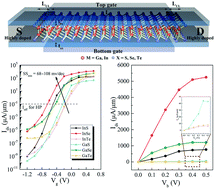High-performance III–VI monolayer transistors for flexible devices†
Abstract
Group III–VI family MX (M = Ga and In, and X = S, Se, and Te) monolayers have attracted global interest for their potential applications in electronic devices due to their unexpectedly high carrier mobility. Herein, via density functional theory calculations as well as ab initio quantum transport simulations, we investigated the performance limits of MX monolayer metal oxide semiconductor field-effect transistors (MOSFETs) at the sub-10 nm scale. Our results highlighted that the MX monolayers possessed good structural stability and mechanical isotropy with large ultimate strains and low Young's modulus, which are intensely anticipated in the next-generation flexible devices. More importantly, the MX monolayer MOSFETs show excellent device performance under optimal schemes. The on-state current, delay time, and power dissipation of the MX monolayer MOSFETs satisfy the International Technology Roadmap for Semiconductors (ITRS) 2013 requirements for high-performance devices. Interestingly, the sub-threshold swings were in a very low range from 68 mV dec−1 to 108 mV dec−1, which indicated the favorable gate control ability for fast switching. Therefore, we believe that our findings shed light on the design and application of MX monolayer-based MOSFETs in next-generation flexible electronic devices.



 Please wait while we load your content...
Please wait while we load your content...